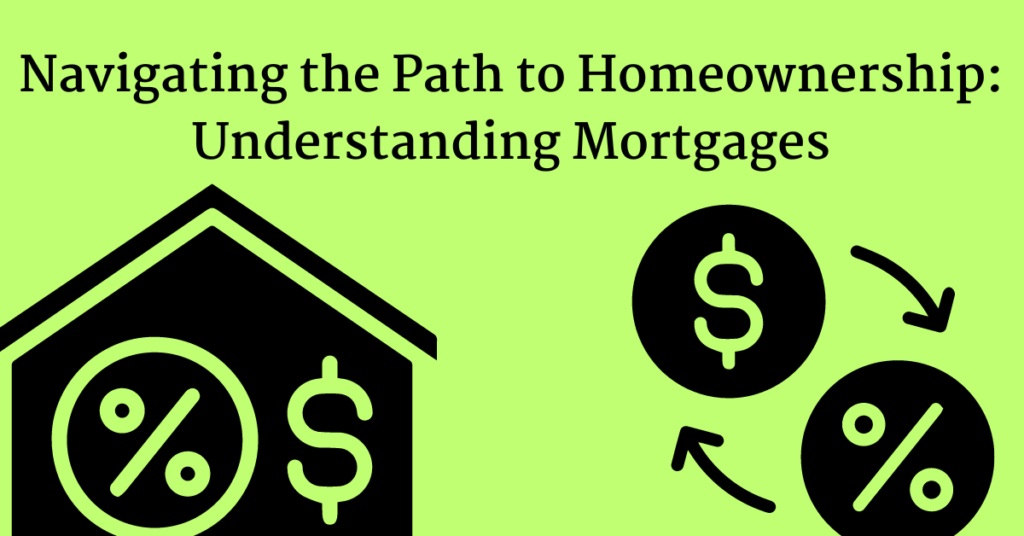Understanding Mortgages – For many people and families, owning a home is a significant accomplishment and a lifelong goal. However, understanding mortgages, the financial instrument that allows millions of people around the world to purchase a home, is often the first step on the path to homeownership. In this article, we’ll look at what mortgages are, how they work, and what borrowers should know before buying a home.
What is a Mortgage?
A mortgage is a loan designed specifically for the purchase of real estate, usually residential property. A mortgage arrangement involves a borrower obtaining financing from a lender, typically a bank or a mortgage lender, to purchase a home. The property itself serves as collateral for the loan, which means that if the borrower fails to repay the loan on the agreed-upon terms, the lender has the right to foreclose and sell the property to recoup their investment.

How Mortgages Work?
Loan Amount: The loan amount represents the total amount borrowed by the borrower to purchase the home. This amount is typically calculated using the purchase price of the property, minus any down payment made by the borrower.
Interest Rate: The interest rate is the percentage that the lender charges on the loan’s principal amount. It represents the cost of borrowing money and is an important factor in calculating the total amount of interest paid over the term of the mortgage.
Loan Term: The loan term, also known as the repayment period, is the time frame in which the borrower agrees to repay the loan. Loan terms for mortgages typically range from 15 to 30 years, though shorter and longer terms may be available depending on the lender and borrower preferences.
Down Payment: The down payment is an upfront payment made by the borrower towards the purchase price of the home. It is usually expressed as a percentage of the purchase price, with typical down payment amounts ranging from 3% to 20% or more.
Monthly Payments: Mortgage payments are typically made on a monthly basis and consist of both principal and interest components. In addition to principal and interest, mortgage payments may also include property taxes, homeowners insurance, and, in some cases, private mortgage insurance (PMI) or homeowners association (HOA) fees.
Types of Mortgages
Fixed-Rate Mortgages: A fixed-rate mortgage ensures that the interest rate remains constant throughout the loan’s term. Borrowers benefit from predictability and stability, as their monthly payments remain consistent regardless of market interest rate fluctuations. Keeping Unwanted Guests at Bay: The Importance of Professional Pest Control
Adjustable-Rate Mortgages (ARMs): Adjustable-rate mortgages have interest rates that can fluctuate over time, typically in response to changes in a specific financial index. While ARMs typically have lower initial interest rates than fixed-rate mortgages, borrowers run the risk of paying more if interest rates rise in the future.
Government-Backed Mortgages: Government-sponsored entities such as the Federal Housing Administration (FHA), the Department of Veterans Affairs (VA), and the U.S. Department of Agriculture (USDA) offer mortgage programs that provide support and assistance to eligible borrowers, including first-time homebuyers and military veterans.
Considerations Before Getting a Mortgage
Credit Score: Lenders use credit scores to determine borrowers’ creditworthiness. A higher credit score typically means lower interest rates and better loan terms. Borrowers should review their credit reports and resolve any issues before applying for a mortgage.
Down Payment: The size of the down payment can impact the terms of the mortgage, including the interest rate, loan amount, and requirement for private mortgage insurance (PMI). Saving for a larger down payment can help reduce monthly payments and long-term interest costs.
Affordability: Borrowers should carefully consider their financial situation and ensure that they can afford the monthly mortgage payments, along with other housing-related expenses such as property taxes, insurance, and maintenance costs.
Closing Costs: In addition to the down payment, borrowers should budget for closing costs, which can include fees for loan origination, appraisal, title insurance, and other services. Closing costs typically range from 2% to 5% of the loan amount.
Conclusion – Understanding Mortgages
Mortgages play an important role in making homeownership possible for millions of people around the world. Borrowers who understand the fundamentals of mortgages, such as loan terms, interest rates, and repayment options, can make informed decisions that are in line with their financial objectives and circumstances. Whether you want a fixed-rate mortgage for stability or an adjustable-rate mortgage for flexibility, selecting the right mortgage product necessitates careful thought and planning.
1 thought on “Navigating the Path to Homeownership: Understanding Mortgages”